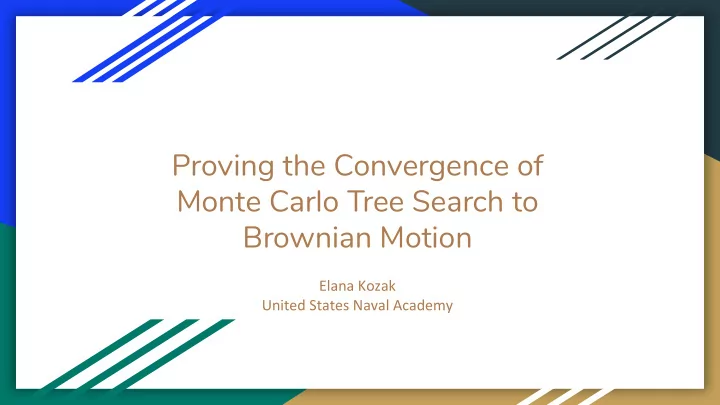

Proving the Convergence of Monte Carlo Tree Search to Brownian Motion Elana Kozak United States Naval Academy
Motivation- Machine Learning Have you ever played a game against a computer? Have you ever talked to Siri or Alexa? Have you ever used GPS to estimate travel time? Has Facebook ever suggested new friends for you? Has Amazon ever suggested a new product for you?
Military Applications ➢ Autonomous warfare platforms ➢ Cybersecurity programs ➢ Logistics and transportation ➢ Target recognition ➢ Combat simulation and training ➢ ISR missions ➢ Data processing ➢ Search and rescue From MarketResearch.com
AI Decision Methods ➢ Random ➢ Cheat ➢ Script ➢ Monte Carlo Tree Search From oreilly.com
“Game” or Decision Tree Game state Root node (v) Child nodes (v i ) Terminal node Generic Tree Tic-Tac-Toe Example
MCTS Steps From Kelly and Churchill, 2017
Upper Confidence Bound (UCB1) aka Upper Confidence Bound for Trees (UCT) V i : node V: parent node Q: win count N: visit count C: exploration constant From int8.io
Current Applications and Advantages ➢ Artificial Intelligence (AI) game players ○ Chess ○ Go ○ Tic-Tac-Toe ○ And more … ➢ Adjustable Computation ○ No initial strategy ○ Only stores end state ○ Set time limit But … not always accurate ➢ ○ Inherent randomness ○ Doesn’t cover all paths
Can we apply MCTS to search and detection? YES! Imagine a game … Moves = up, down, left, right Goal = find the target Our question: how does this method behave?
Theorem 1 A 2-D Monte Carlo Tree Search that uses the UCT selection policy and a uniformly random, unknown target will converge to a symmetric random walk as M, the size of the search lattice, goes to infinity.
Proof ● Let ε>0 and choose K(ε) such that (1/K(ε)) < ε as the radius of a region E around the origin ○ Thus K(ε) is the minimum number of steps required to exit this region ● Choose M as the dimension of the square grid such that P(dist(T, S(0))> K(ε)) = 1- δ ● Q = 1/k represents the success rate On average, k >> K(ε) so Q < 1/K(ε) < ε ○ Recall:
Proof (continued) V 1 ● N(v) is the same for all v i 1. First four trials pick i randomly, then UCT is equal for all i V 2 2. Visited nodes have a lower UCT, so next move is chosen randomly from remaining nodes V 4 3. Process repeats, randomly cycling through the moves since UCT is always equal V 3 Recall:
Future Work ❖ Theorem 2: When a stationary target is known, a 2-D Monte Carlo Tree Search will converge to an optimal “straight” line path as the number of iterations goes to infinity. ❖ Test MCTS in more complex scenarios ➢ More targets ➢ More searchers ➢ Different distributions ❖ How does MCTS compare to other search methods? ➢ Time, accuracy, computational complexity, etc. ❖ What real-world scenarios can we apply MCTS to? ➢ Search and rescue ➢ Animal foraging ➢ Submarine detection
Thank You
Recommend
More recommend